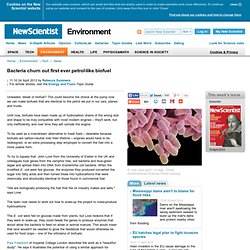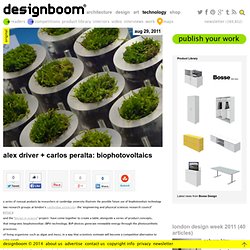

Bacteria churn out first ever petrol-like biofuel - environment - 24 April 2013. Unleaded, diesel or biofuel?

This could become the choice at the pump now we can make biofuels that are identical to the petrol we put in our cars, planes and trucks. Until now, biofuels have been made up of hydrocarbon chains of the wrong size and shape to be truly compatible with most modern engines – they'll work, but only inefficiently, and over time they will corrode the engine.
Moss Table @ Designersblock 2011. Biophotovoltaics. Biophotovoltaics – generating energy from photosynthesis. Biophotovoltaics – generating energy from photosynthesis Posted by Adriana Siso on February 5, 2012 · Leave a Comment.

Alex driver + carlos peralta: biophotovoltaics. Aug 29, 2011 alex driver + carlos peralta: biophotovoltaics a series of concept products by researchers at cambridge university illustrate the possible future use of biophotovoltaic technology two research groups at london’s cambridge university– the ‘engineering and physical sciences research council’ (EPSRC) and the ‘design in science‘ project– have come together to create a table, alongside a series of product concepts, that integrates biophotovoltaic (BPV) technology.

BVP devices generate renewable energy through the photosynthetic processes of living organisms such as algae and moss, in a way that scientists estimate will become a competitive alternative to solar panels within the next five to ten years. UK Designers Display 7 Innovative Everyday Uses for Biophotovoltaic Panels Powered by Algae.
Did you ever dream that your reading lamp would one day be powered by living organisms?

Well, commercialization of such a product is at least five years out, but UK designers are working furiously with Cambridge University researchers to develop biophotovoltaic (BPV) devices that generate renewable energy from the photosynthesis of algae and moss. World's First Algae-Powered Building by Splitterwerk Architects Opens This Month in Germany. We’ve all heard about buildings powered by solar or wind energy, but an algae-powered building?

Splitterwerk Architects have designed just such a structure, dubbed BIQ, which will be the very first of its kind. Covered with a bio-adaptive façade of microalgae, the distinctive building has been designed for the International Building Exhibition in Hamburg and is slated to open this month! To create the algae façade, the building is covered in bio-reactive louvers that enclose the algae. These louvers allow the algae to survive and grow faster than they would otherwise while also providing shade for the interior of the building. Additionally, the bio-reactors trap the heat energy created by the algae, which can then be harvested and used to power the building. The project is a collaboration between Spitterwerk Architects, Strategic Science Consult of Germany, ARUP and Colt International, who are responsible for the louver design.
CREST Research - Biophotovoltaic Devices. Development of Bio-Photovoltaic Devices Increased awareness of the environmental effect of using fossil fuels as well as government targets to reduce carbon dioxide emmisions have resulted in an increased interest in methods of harnessing solar energy.

Traditional techniques are based around the photovoltaic effect and have been succesefully developed to produce a commercially viable product. However, the device contains expensive, high-purity semi-conductors so alternative techniques using cheaper material but maintaining the high conversion efficiency are being investigated. We are currently working on developing an alternative technique, the bio-photovoltaic device. This exploits the photosynthetic apparatus of biological material, such as cyanobacteria or algae, to convert the solar energy into electrical energy and then uses this electrical energy to drive a current or create a potential difference to drive a chemical reaction. Photosynthetic molecule plus semiconductor make efficient biophotovoltaics.
Microsoft Word - Factsheets combined.docx - factsheets.pdf. Biodieselmagazine.com. After more than a decade of healthy growth for conventional biofuels such as biodiesel and ethanol, the next wave of advanced biofuels is nearing commercialization.

The pool of commercially available biomass-derived fuels is expanding to include advanced fuels derived from nonfood feedstocks and drop-in synthetic substitutes for gasoline, diesel, and kerosene-based jet fuel. According to a new report from Navigant Research, worldwide biofuels production will grow from 33.6 billion gallons per year (BGY) in 2013 to 61.6 BGY in 2023.
“North America is leading the transition to advanced biofuels, but healthy growth in Europe, Asia Pacific, and Latin America is helping to diversify the fuel supply for a range of transportation applications,” said Mackinnon Lawrence, principal research analyst with Navigant Research.
Fraunhofer Institute Powers Electronics With Body Heat. Body Heat Power (Source: Image via Fraunhofer) Future electronic devices could be powered by body heat alone For mobile professionals, poor battery life from a device is the ultimate enemy to staying connected on the go.

Everyone wants longer battery life from phones, laptops and cameras. Researchers from the Fraunhofer Institute for Integrated Circuits IIS in Erlangen have teamed up with scientists from the Fraunhofer Institute for Physical Measurement Techniques IPM and the Fraunhofer Institute for Manufacturing Engineering and Applied Materials Research IFAM to devise a way to power electronic circuits by using body heat. The researchers were able to construct a method of turning body heat into electricity using the same principal as thermoelectric generators (TEG) made from semi-conductor elements.
That means that with such a small temperature difference, the amount of electricity generated is very low voltage.